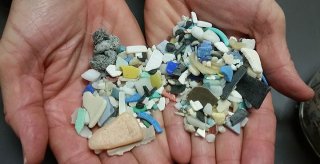Microplastics Research

Plastics have become pervasive in natural and built environments, causing concerns about how they can potentially harm humans and the environment. EPA researchers define microplastics, or MPs, as plastic particles ranging in size from 5 millimeters (mm), which is about the size of a pencil eraser, to 1 nanometer (nm). For comparison, a strand of human hair is about 80,000 nanometers wide. Primary microplastics are intentionally manufactured in small sizes for their use in consumer products, such as cosmetics or biomedical products. Secondary microplastics are plastic particles that break down from larger plastic materials, such as food wrapping, tires and synthetic textiles.
Microplastics are likely to degrade into smaller nanoplastics through chemical weathering processes, mechanical breakdown, and even through the digestive processes of animals. Nanoplastics, or NPs, are a subset of microplastics and they are smaller than 1 µm (1 micrometer or 1000 nm). Nanoplastics cannot be seen by the human eye.
Microplastics have been found in every ecosystem on the planet, from the Antarctic tundra to tropical coral reefs, and have been found in food, beverages, and human and animal tissue. The wide range of particle sizes, densities, and compositions pose a challenge for researchers because there is not a single method that can be used to characterize the wide variety of micro and nanoplastic particles. There is a pressing need to develop and standardize collection, extraction, quantification, and identification methods for micro and nanoplastics to improve reliability, consistency, and comparability across studies. These methods are needed across medias such as sediment, surface water and aquatic species.
Characterization and Quantification
EPA researchers have been addressing plastic pollution in the aquatic environment by establishing reliable and reproducible methods for sampling micro and nanoplastics.
Method Development Focus
- Separating plastics from organic and inorganic contaminants found in environmental samples
- Extracting plastics from environmental samples without harsh chemicals or heat that further degrades plastic
- Developing monitoring programs in the Chesapeake Bay
Researchers are also using state-of-the-art analytical chemistry instruments to characterize and quantify total microplastics and the different types of plastic polymers in water and sediment samples.
Health Effects Methods
EPA scientists are adapting existing methods and developing new methods to evaluate how microplastics, particularly nanoplastics, impact human health and aquatic life.
Human Health Impacts Focus:
- Developing applications of in vitro and computational toxicology approaches to assess health impacts from exposure to microplastics in experimental models
- Developing methods, models, and tools to evaluate cellular uptake and clearance of microplastics using cell cultures
Aquatic Life Impacts Focus:
- Determining the potential toxicological impacts of bio-based or biodegradable plastics on aquatic life
- Evaluating the cumulative effects on coral growth from exposure to environmentally relevant microplastic concentrations and elevated temperatures
- Examining biological impacts to fish diets
Related Research and Resources
- EPA's Trash Free Waters Program
- Microplastics Information from the National Oceanic and Atmospheric Administration
- Nanomaterials Research
- National Aquatic Resource Surveys and National Assessment
- Plastic Pollution Action Team at the Chesapeake Bay Program
- Watersheds Research
- Interstate Technology Regulatory Council (ITRC) Microplastics Outreach Toolkit
Publications on Microplastics
- Microplastics Publications in Science Inventory
- Science Matters Story: Making Microplastic Identification More Accessible
- Science Matters Story: Tiny Plastics, Big Threat: How Are Microplastics Impacting Our Coral Reefs?
